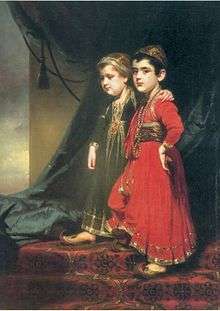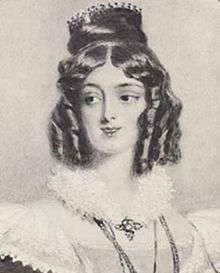Kitty Kirkpatrick
Katherine Aurora "Kitty" Kirkpatrick (9 April 1802 – 2 March 1889) was a British Anglo-Indian woman[1] best known as a muse of the author Thomas Carlyle, and as an example of Eurasian children during the early years of British colonialism in India.
Kitty Phillipps | |
|---|---|
 "Portrait of William and Catherine Aurora, children of Lieutenant-Colonel James Achilles Kirkpatrick", by George Chinnery, ca. 1805. | |
| Born | Noor un-Nissa, Sahib Begum 9 April 1802 Hyderabad, State of Hyderabad |
| Died | 2 March 1889 (aged 86) |
| Nationality | British |
| Other names | Katherine Aurora Kirkpatrick |
Biography
Early life
Kitty Kirkpatrick was born on 9 April 1802, in Hyderabad in the State of Hyderabad, a large principality in the southern Indian Subcontinent under British paramountcy. Her father, James Achilles Kirkpatrick, was the British Resident in Hyderabad and a colonel in the British East India Company's army. Her mother, Khair-un-Nissa, was a Hyderabadi noblewoman and a Sayyida, a lineal descendant of the Muslim prophet Muhammad, whose grandfather was the prime minister of Hyderabad.[2] The two had met in the court of the Nizam of Hyderabad, and were married in a Muslim ceremony. James Kirkpatrick, a Christian, underwent some degree of conversion to Islam to be permitted to marry Khair-un-Nissa, but is not clear whether the marriage or the conversion were recognized as legal.[2]
Kitty was initially named Noor un-Nissa, Sahib Begum ("Little Lady of High Lineage") and was raised alongside her brother William (known as Mir Ghulam Ali, Sahib Allum) in the mansion her father built, the British Residency, Hyderabad, living in the zenana with her mother and grandmother. James was a doting father and is known to have spent a lot of time with his wife and small children. In 1805, Kitty and William were sent to live in England at age three and five years, respectively, with their paternal grandfather, Colonel James Kirkpatrick. At the time, it was common for British families in India to send their young children to Europe as death rates for children in India were frighteningly high, and families wanted them to grow up as British, speaking unaccented English and being educated at a British school or by British tutors in a British home, before returning. The well-known painter, George Chinnery, created a portrait of the siblings in Madras, shortly before they were sent to England. The two children were baptised as Christians on 25 March 1805, at St Mary's Church, Marylebone Road in London, and were thereafter known by their new Christian names, William George Kirkpatrick and Katherine Aurora "Kitty" Kirkpatrick.[3] They never again saw India or any members of their maternal family.[2]
James Kirkpatrick died on 15 October 1805, around 8 months after Kitty and William had left India.[4][2] In his will, James describes William and Kitty as his "natural children," leaving large fortunes to each, and left money to his nieces and nephews, the children of his brother William Kirkpatrick, to whom he was deeply indebted for launching his lucrative career with the East India Company. William Kirkpatrick, who had needed to retire to England mid-career due to poor health, had arranged for James to step into his prestigious and lucrative position as Resident at Hyderabad. James used his fortune to support William Kirkpatrick and his children out of his love for and gratitude toward his elder brother.[2] Following James' death and the absence of her children, Khair-un-Nissa, who had lived in strict purdah during his lifetime, began a relationship with Henry Russell, one of James' assistants. Only 19 years-old at the time, Khair-un-Nissa was abandoned by Russell, destroying her reputation among the Hyderabadi elite and was forced into exile, unable to prevent greedy relatives from taking over the valuable landed estates she had inherited from her father.[2]
Life in England

Kitty and her brother William had substantial sums settled on them by their mother, which allowed for them to be raised and educated in middle-class comfort in England. Kitty was educated privately and brought up to emulate the ideal of the Christian lady. In 1812, William suffered a severe burn injury resulted in the amputation of one of his arms, and became reclusive thereafter, though he successfully graduated from Oxford University in 1820, married, and had three daughters before his early death in 1828. Her brother's death, as well as that of her grandfather and other relations, left Kitty with a substantial inheritance estimated at about £50,000. After the death of her grandfather, Kirkpatrick lived with various of her married cousins: Clementina, Lady Louis; Julia, the wife of Edward Strachey; and (Barbara) Isabella, the wife of Charles Buller, a Member of Parliament and mother of Charles Buller junior.
Into adulthood Kitty became known for her attractiveness, and in 1822, while staying with the Bullers, she met the Scottish philosopher and historian, Thomas Carlyle, who was then employed as the Buller children's tutor and who swiftly became infatuated with Kirkpatrick. The romance was encouraged by another of Kitty's cousins, Julia (who married Edward Strachey, grandfather of the writer Lytton Strachey). However, Carlyle was impoverished and not believed by the rest of the family to be a suitable match for the wealthy and well-connected Kitty.[5] Carlyle would later use Kitty as the basis for the Calypso-like Blumine in his novel Sartor Resartus and his memoirs, written many decades later, wrote a pen portrait of Kitty admiring her beauty but is clearly suspicious of her mixed-race ancestry:[6]
a strangely complexioned young lady, with soft brown eyes and floods of bronze-red hair, really a pretty-looking, smiling, and amiable though most foreign bit of magnificence and kindly splendour
— Thomas Carlyle, Reminiscences
On 21 November 1829, Kitty married James Winslowe Phillipps (1802-1859), an army officer in the 7th Hussars Regiment, and a member of the Kennaway family, which also had Indian connections. It was evidently a happy marriage, Kirkpatrick and Phillipps went on to have seven children, of whom four survived to adulthood: Mary Augusta (1830-1909), John James (b. 1834), Emily Georgina (b. 1835), and Bertha Elizabeth (1840-1875).[7]
Renewed contact with India
Kirkpatrick's paternal family had long forbidden her from maintaining any contact with her family in India. However, with the help of Henry Russell, her father's former assistant and her mother's ex-lover, Kirkpatrick was able to re-establish contact with her maternal grandmother after almost four decades of separation. Although they were never physically re-united, the two women were correspondents on a regular and often emotional basis for six years.
Kirkpatrick's letters make it clear that despite leaving India and her mother at such a young age, she still retained vivid memories of it:
I often think of you and remember you and my dear mother. I often dream that I am with you in India and that I see you both in the room you used to sit in. No day of my life has ever passed without my thinking of my dear mother. I can remember the verandah and the place where the tailors worked and a place on the house top where my mother used to let me sit down and slide. When I dream of my mother I am in such joy to have found her again that I awake, or else am pained in finding that she cannot understand the English I speak. I can well recollect her cries when we left her and I can now see the place where she sat when we parted, and her tearing her long hair. What worlds would I give to possess one lock of that beautiful and much loved hair! How dreadful to think that so many, many years have passed when it would have done my heart such good to think that you loved me & when I longed to write to you & tell you these feelings that I was never able to express, a letter which I was sure would have been detained & now how wonderful it is that after 35 years I am able for the first time to hear that you think of me, and love me, and have perhaps wondered why I did not write to you, and that you have thought me cold and insensible to such near dear ties.
— Katherine Kirkpatrick, White Mughals, 386-87
Kirkpatrick died at her home, the Villa Sorrento, in Torquay, Devon, in 1889.
Further reading
References
- Dalrymple, William (2002). White Mughals: Love and Betrayal in 18th Century India. Viking. pp. 1–459. ISBN 0670031844.
- Dalrymple, William (2002). White Mughals: love and betrayal in eighteenth-century India. Penguin Books. ISBN 0-14-200412-X.
- White mischief, The Guardian, 9 December 2002.
- "Noor un-Nissa, Sahib Begum 'Kitty' KIRKPATRICK, later christened Katherine Aurora". The Kirkpatrick Family Archives. Retrieved 4 March 2017.
- Anthony Gardner: Author and Journalist - Interviews (Tatler, 2002)
- Colonial Grandeur, The Hindu, 27 February 2005.
- "Noor un-Nissa, Sahib Begum 'Kitty' KIRKPATRICK, later christened Katherine Aurora". The Kirkpatrick Family Archives. Retrieved 4 March 2017.